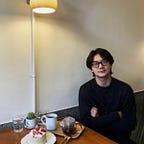蔡坤霖 | 《鷲嶺》與《半⽉沉江府城遊》“Tsiu Nia” and “Taiwanfou” by Kuen-lin Tsai
蔡坤霖作品《鷲嶺》,將七片多邊形的木刻版畫進行拼接,整體造型形同一錐形丘嶺地安置於布滿木條細屑的展櫃上方,彷彿作品才甫於不久前經藝術家製作完成一般的別具新意。畫面上條理式的、帶有筆觸感的刀痕肌理聚散分布於木板表層,隨主題的重要性與前後景關係,分別透過粗細分明的線條進行刻畫,並以深黑及褐色為主調,墨印線與原木基底色調形成鮮明對比。木刻板組合而成的板雕塑,頂端並非落點於正中心處,整體重心稍嫌傾斜,然因四周邊角長短不一,而達到整體結構平衡的視覺效果,形同自然的丘嶺風景一般,單純觀看亦能自成一格。畫面以臺南老城區城牆進行串聯,藉以框製出老臺南舊時面貌,並作為各作品塊面之間故事銜接的過道。藝術家以臺南中西區景點為主,北區、東區、南區、安平區為輔,繪製府城內的歷史與社會脈動。有趣的是,藝術家實地考察⽥調後,盡可能將畫面地標並依實際地理與時代演進脈絡進行布局,藉由對這片土地的身體意識與情感認同進行敘述式的串接與組合。
「鷲嶺」為臺南老城區內地勢最高之處,與赤崁、崙仔頂、山川臺、山仔尾、尖山、覆鼎金合稱為「府城七丘」或「鳳凰七丘」[1]。蔡坤霖以「七丘」、「七鯤鯓」為概念出發,跨有山與海之意向,將畫面區分為七個組件加以闡述,綜觀自明朝迄今的時代演繹,以府城城牆內(藝術家所認定的)代表性建築空間與地方氛圍分別繪製於畫面之中,藉由水印木刻版畫等媒材,拓印出可居可遊的視覺意象空間,由左至右可見北城門、臺南火車站、兌悅門、赤崁樓(普羅民遮城)、安平古堡(熱蘭遮城)、逐步淤積而成的五條港與臺江內海、接官亭、看西街長老教會、奠坤門、小西門、臺南神社(今南美館2館現址)、臺南市美術館2館、武德殿、林百貨、文學館、城隍廟、北極點、天公廟(天壇)、寧南門、小南門、南山公墓…等。綜上所見,時代建築與歷史錯綜複雜,從地緣關係上能見臺南便是一個經由多重的殖民文化、歷史脈動所積累而成的所在。藝術家也加以描繪出重點事件、人物、物件,如湯德章紀念公園(湯德章於二二八事件中遭國軍槍決之場面)、劉永福黑旗軍與藍地黃虎旗(臺灣民主國國旗)、美軍零式艦上戰鬥機、牧師巴克禮(Thomas Barclay),從中也可見臺南小空港上的日軍零式戰機(神風特攻隊)及美軍B-24轟炸機空襲畫面,使人們的生命記憶與歷史連動,形塑出地方特有的意識與反饋。
相比《鷲嶺》須移動身軀進行環景式、片段式的觀看與記憶重組,由版雕塑翻印而成的《半⽉沉江府城遊》,除了整體畫面因複印而產生鏡射,進而呼應現實場景的地理方位,並以東方水墨橫向閱讀空間的佈局精神,完整的府城場景便一覽無遺,觀者更易於踹摩當地人文特色與詳讀畫面細節。
[1]國家文化總會、教育部(2010).《走讀臺灣:臺南市1》. p 14、22-24.
Kuen-lin Tsai’s work Tsiu Nia (Eagle Hill) pieces seven polygonal woodcut prints together to form a cone-shaped hill. The work is creatively placed above a showcase full of wooden slivers, implying that the artist had just recently completed the work. The artist created woodcut marks that leave an orderly, brush-stroke texture on the woodblock panels. Depending on the importance of the themes and the relationship between the background and the main scene, the artist created used coarse and thin lines, as well as dark black and brown color tones. The dark print lines contrast sharply with the wooden base tone. With this woodcut sculpture composed of prints, the pinnacle of the sculpture does not fall at the exact center but is slightly inclined. The surrounding sides are different in length, creating a balanced visual effect of the overall structure, which resembles the natural landscape of a hill. Each woodcut print can be viewed separately or together as an entire sculpture. The old city walls of Tainan connect the different images and frame the scenes of historical Tainan. The walls also serve as a passage between the different segments of stories. To capture the historical and social pulse of the city, the artist mainly focuses on the scenic spots in Tainan’s Central and Western District, with supplementary works on sites in the Northern District, Eastern District, Southern District, and Anping District. What interesting is that the artist, based on his field study works, painstakingly laid out the landmarks in a way that closely adheres to the actual geographic and historical context. Through his physical consciousness and emotional identity with this land, the artist connects and assembles these landmarks in his narration practice.
Tsiu Nia (Eagle Hill) is the highest point in old town Tainan. Together with Chihkan, Lunziding, Shanchuantai, Shanziwei, Jianshan, and Fudingjin, they are collectively called “the Seven Hills of Fucheng (historical Tainan)” or “the Seven Hills of Phoenix”3. Based on the concepts of “Seven Hills” and “Seven Sand Banks (kunshen)” that encompass mountains and seas, Tsai divided the picture into seven components. He illustrated how the city has evolved from the Ming Dynasty to the present and created iconic architectural spaces and locations within the frame made of old city walls. Using watermark woodcut prints and other mediums, the artist created a visual image space where one can actually live in and visit. From left to right, one can see North Gate, Tainan Train Station, Duiyue Gate, Chihkan Tower (Fort Provintia), Anping Fort (Fort Zeelandia), the Five Old Channels and Taijiang Inner Sea (land gradually formed by siltation), Jieguan Pavilion, Kanxi Street Presbyterian Church, Diankun Gate, Little West Gate, Tainan Shrine (current location of Hall 2 of the Tainan Art Museum), Tainan Art Museum, Wude Hall, Hayashi Department Store, National Museum of Taiwan Literature, Chenghuang Temple, Beiji Temple, Temple of Heaven (Tiantan), Ningnan Gate, Little South Gate, Nanshan Public Cemetery, and so on. To sum up, we see that the architectures of different time periods have been intricately tied to various historical stages in Tainan, showing that this is a place where forces of different colonial cultures and histories have intermingled and forged the character of the city. The artist also depicted key historical events, figures, and objects. For example, the Tang Dezhang Memorial Park (the site where Mr. Dezhang Tang was executed by the Chinese army in the February 28th Incident), Yongfu Liu’s Black Flag Army, the national flag of the Formosan Republic (the Yellow Tiger on the Blue Ground Flag), A6M zero fighter, and Reverend Thomas Barclay. He also showed air-raid scenes at Tainan’s small airport by the Japanese Zero Fighter Jets (Kamikaze Task Force) and the U.S. B-24 bombers. These scenes were meant to evoke people’s memories about history, thus forming an unique local identity and awareness.
With Tsiu Nia, a viewer has to move his/her body around in the exhibition space to view the works in segments and to experience the re-structuring of memories. As for The Castle Town (Half-moon Sinking into Taijing Inner Sea — A Trip around Historical Tainan), it is a woodcut sculpture. Because of the replicated prints, viewers see mirror images that reflect the actual geographic locations. The artist also applied traditional Chinese ink painting to create a horizontal reading space for viewers to study the details of the artwork. This is a work that allows viewers to enjoy an expansive view of Tainan’s historical landscape and appreciate the cultural characteristics.
展覽:永聲花 — — 無盡的聲音風景
展期:2021.04.01–2021.10.17
地點:臺南市美術館2館三樓 藝術走廊
參展藝術家 | Nigel Brown / 吳修銘 / 吳燦政 / 郭佩奇 / 莊普 / 蔡坤霖 (依筆畫順序排列)
策展團隊|蕭楷競 / 林睿洋 / 陳琪涵
Artists | Nigel Brown / WU Siou-Ming / WU Tsan-Cheng / KUO Pei-Chi / TSONG Pu / TSAI Kuen-Lin (names in alphabetical order)
Curatorial Team|Kai Ching HSIAO / Rui Yang LIN / Chi Han CHEN
